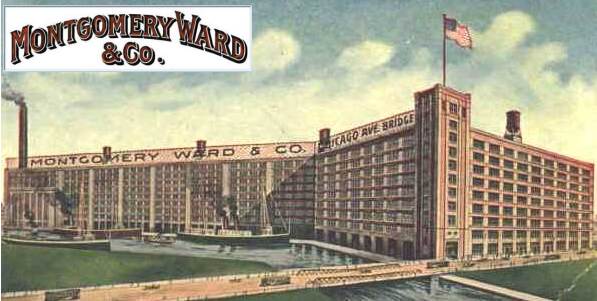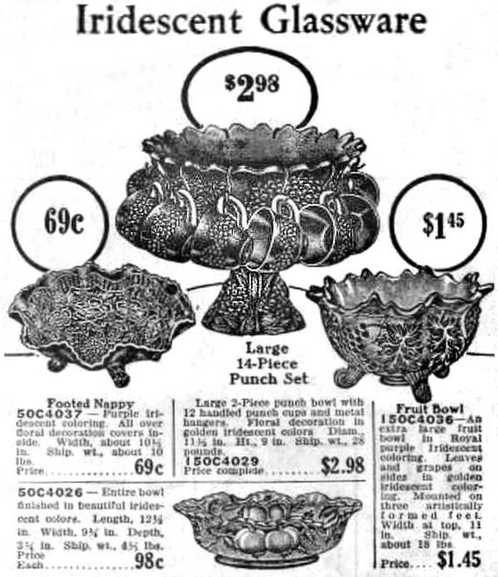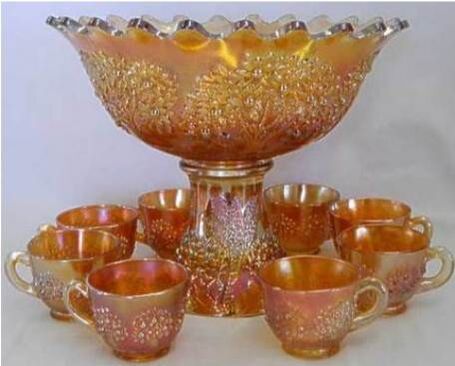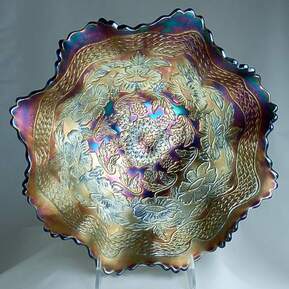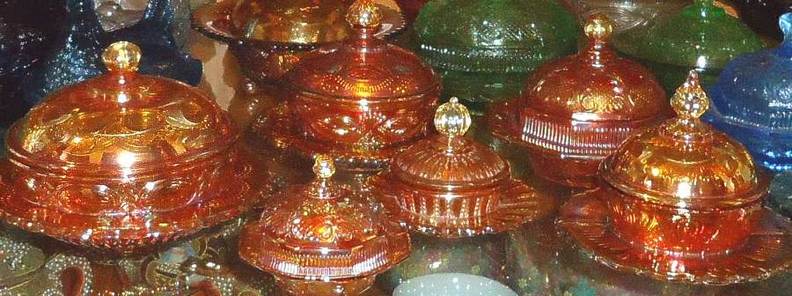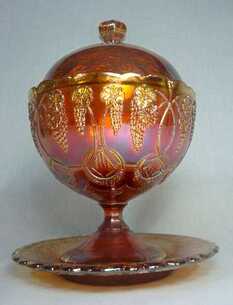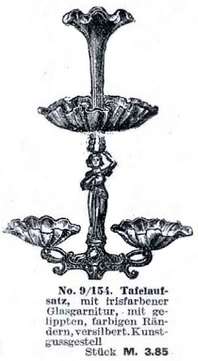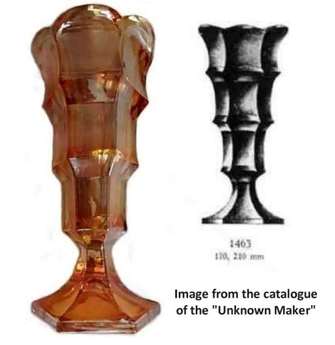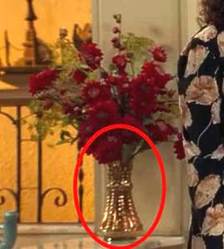NetworK ezine Issue 11. April 2016
by Glen and Stephen Thistlewood
Amazing how time flies! It was twenty two years ago - in 1994 - when we launched our original (printed) NetworK journal on Carnival Glass, and within a year we were mailing copies all over the world.
The aim of NetworK has always been very straightforward: to spread the word about Carnival Glass to an international network of collectors. It combines our own research and writing with wonderful and unique contributions from our fellow collectors and researchers all over the world. NetworK moved online last year. It is free for everyone - to read, to share and to contribute.
Please feel free to share NetworK with other glass collectors and enthusiasts - help us spread the word. Thanks!
We hope you enjoy our April 2016 edition. We avoided sending it out on April 1st. (April Fools Day!) - we didn’t want to risk that!
The aim of NetworK has always been very straightforward: to spread the word about Carnival Glass to an international network of collectors. It combines our own research and writing with wonderful and unique contributions from our fellow collectors and researchers all over the world. NetworK moved online last year. It is free for everyone - to read, to share and to contribute.
Please feel free to share NetworK with other glass collectors and enthusiasts - help us spread the word. Thanks!
We hope you enjoy our April 2016 edition. We avoided sending it out on April 1st. (April Fools Day!) - we didn’t want to risk that!
Satisfaction Guaranteed Or Your Money Back
|
“Satisfaction Guaranteed or Your Money Back” was one of the slogans used by the famous Montgomery Ward mail order house from its early days.
Another of their well-known mottos was “You Can’t Go Wrong When You Deal With Montgomery Ward” - however, things began very wrongly indeed for the famous firm when their entire first stock was incinerated in the Great Fire of Chicago in 1871. Not one to be put off by adversity, Aaron Montgomery Ward launched his first mail order catalogue in 1872. By the start of the 1900s, Montgomery Ward’s mail order catalogues contained anything and everything the customer could possibly want, proclaiming that they carried: “Supplies For Every Trade and Calling On Earth”. |
Now a National Historic Landmark in Chicago, this was originally constructed in 1908 to house the Montgomery Ward Company's central warehouse. (Image courtesy of Wikimaps).
|
Did they sell Carnival Glass?
Of course they did! In 1916, they showed a range of marigold Lustre Rose items from Imperial and then just a few years later in 1920, the splendid ad (shown below, left) for “Iridescent Glass” appeared in their catalogue.
In this extract you can see, on the left, a 10 inch Two Flowers footed bowl, described as having “purple iridescent coloring”. Note it is described as a “Footed Nappy” – we tend to use the term “nappy” today to describe the smaller bowls. In the middle is a 14-piece Orange Tree Punch Set, described as being in “golden iridescent colors”.
And on the right, a Grape and Cable large, 11 inch wide, footed fruit bowl, described as being in “Royal purple iridescent coloring” and “mounted on three artistically formed feet.” These three items were all from Fenton, but note that the other piece – the large Peach and Pear oval bowl shown at the bottom of the ad, is from Dugan/Diamond.
Of course they did! In 1916, they showed a range of marigold Lustre Rose items from Imperial and then just a few years later in 1920, the splendid ad (shown below, left) for “Iridescent Glass” appeared in their catalogue.
In this extract you can see, on the left, a 10 inch Two Flowers footed bowl, described as having “purple iridescent coloring”. Note it is described as a “Footed Nappy” – we tend to use the term “nappy” today to describe the smaller bowls. In the middle is a 14-piece Orange Tree Punch Set, described as being in “golden iridescent colors”.
And on the right, a Grape and Cable large, 11 inch wide, footed fruit bowl, described as being in “Royal purple iridescent coloring” and “mounted on three artistically formed feet.” These three items were all from Fenton, but note that the other piece – the large Peach and Pear oval bowl shown at the bottom of the ad, is from Dugan/Diamond.
The Carnival Glass pieces shown above, right, are Fenton: an Orange Tree punch set in marigold (courtesy Seeck Auctions), and a blue Two Flowers bowl.
You can read much more about Montgomery Ward (including the story of the man who tried to buy himself a wife) and see more photos and illustrations, in the full Montgomery Ward article.
Butters from Brazil
Carnival Glass was not only produced worldwide, it is also collected and studied worldwide, and we are proud to present a unique feature, courtesy of Cláudio Deveikis and Álvaro Henrique Nicolau Aguiar from Brazil: a splendid array of fascinating butter dishes from that country.
|
The amazing display of butter dishes shown above both tantalises and intrigues. Some have a familiar look to them while others are mysterious and rather exotic. Carnival Glass found in South America continues to provide surprises, and we are honoured that researchers and collectors in that part of the world have chosen to let us feature and share their information. Our website has a huge and growing amount of information about Carnival Glass discoveries in South America. The latest is a major new feature on butter dishes, most of which have never been shown before. Click here to see 12 covered butters and compotes from Brazil. Cláudio also shows us two fabulous covered compotes. Here’s one of them on the right. It's called "Little Grape”. It is magnificent! Goodness! The Goddess! |
|
This splendid illustration of what is surely the Goddess of Athena Carnival Glass epergne, was shown in a Berlin department store catalogue in 1914. The sweetest part is the description of the glass as irisfarben – iridised – Carnival. Another epergne in the same catalogue had a glass bowl and horn in what is arguably the Diamond Swirls pattern that some other Carnival epergnes feature. These items were surely made in Bohemia, which was of course, renowned for its early production of iridescent glass. Interestingly, most of the currently reported examples of Goddess epergnes and similar, were found in the USA. Our recent research turned up a most interesting snippet in a 1907 New Jersey newspaper about a fruit dish featuring a bronze female figure supporting iridescent Bohemian glass. Looks like the Goddess epergnes were probably imported into the USA from around 1907. There's much to read and see in our article about these stunning epergnes with metal bases, including some fascinating pages from the German department store catalogue. |
Czech Vase Discovery
|
Lance and Pat Hilkene sent us this photo of a most unusual vase they had recently purchased. How exciting when we realised it was a previously un-reported item and it features in the catalogue of the “Unknown Maker” * The vase is Pattern Number 1463, made in two sizes; 8 inches, as shown here, and a slightly smaller one around 6 and a half inches. Thanks to Lance and Pat for sharing this intriguing discovery. * Note: the attribution, “Unknown Maker”, is because there is no maker’s name on the cover of their catalogue: we know it is Czech and our previous research suggests the maker was actually Rosice. |
Carnival Glass on TV
|
Eagle-eyed Cláudio Deveikis saw this beautiful vase featured in a TV set in Brazil, during the soap opera “Êta Mundo Bom”. The vase you can see circled is Brazilian - Aztec Headdress. Êta Mundo Bom is produced by "Rede Globo de Televisão". Our grateful thanks to Cláudio for sending it to us. Carnival Glass has been seen in "period" TV programmes before, but Brazilian TV is a first for us! |
Finally … did you know there are TWO distinctly different versions of Imperial’s Windmill pattern on the large sized bowl?
Which version do you have? Check them out here.
If you missed earlier issues, they are on our NetworK back issues page.
Which version do you have? Check them out here.
If you missed earlier issues, they are on our NetworK back issues page.

